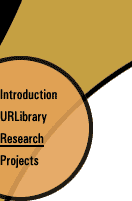Design Metaphors
"…one generation's realizations of a metaphor can become part of the next generation's experiential basis of that metaphor."( Lankoff 1993)
Design metaphors are powerful heuristic devices that can help to describe and explore new ideas in terms and concepts found in more familiar domains. Many have argued that the power of a metaphor to explain, organize and structure the unfamiliar in terms that are more familiar can also constrain and even construct answers to problems that are in part framed by the use of that metaphor (Schon, Black, Lankoff). This research initiative explores the roles, limitations, and benefits of metaphors used in the design process.
What Use Is Space? (in Collaborative Virtual Workspace)
[285KB pdf], Twig Gallemore, 1998
[ABSTRACT] Many collaborative systems use spatial metaphors to organize and structure the virtual environments in which people interact with information tools and each other. This research will argue that although spatial metaphors provide a useful framework for development and use of collaborative systems they also raise additional challenges. Drawing on the experiences of the development team and group of users of a "place-based" collaborative system, Collaborative Virtual Workspace (CVW), as well as current research in collaborative virtual environments and workplace making, this research will consider the role of space in the design and use of collaborative systems. In light of how spatial metaphors are being used in collaborative systems and the challenges they pose, this research will consider to what extent and under what circumstances are spatial metaphors in fact useful or tangential from a designer's and a user's perspective of collaborative virtual environments. It is our intention that from this study, we may gain further insight into the role of spatial metaphors in the design and use of collaborative systems from which (spatial) design strategies may then be considered.
Space, Place and Interface
Technology is changing the way we live, work, play and learn. The virtual office, and virtual classroom, e-commerce and virtual reality are examples of how technology is conceived from experiences, relationships and convention developed in our physical environment. But the rules are different on the electronic frontier. How do we move beyond conventional models and design an environment that is natural, where we do not have to preface a concept with "virtual" or e-.
This research initiative considers relationships between information technology and physical infrastructure in the design of space, place and interface.
Virtual Workplaces
[ABSTRACT] Our model of work is shaped by the places we choose to work and the tools we choose to work with. As we introduce new technologies and build new environments our model is changing. Today's virtual workplaces are grounded in models of work that have been reformed from our experiences using current technology in physical workspace. However we are discovering opportunities and possibilities for work in collaborative, virtual environments that question physical models. Emerging patterns of distributed collaboration in persistent virtual environments are changing the way we work in time and space recasting our notion of workplace. Virtual workplaces are understood and experienced through metaphors that describe a space of potential for work occurrences. Through the lens of metaphors, this research focuses on breakdowns between collaborative work and the environment in which work occurs. If what we understand and predict is based on what we already know, then by examining the breakdowns between design and use of collaborative environments we can illuminate the space of possibilities for collaborative work.






